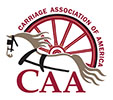
#7) Arrive with bells on! Everyone warns drivers about deer and elk encounters, occasionally we hear of a bear sighting and everyone watches out for snakes. My most dangerous encounter, so far, has been with a duck. It burst out of a deep ditch, flying as fast as it could! At that moment in time I didn’t know what was happening, my horse and I just ducked. Fortunately, I was driving a good horse who straightened himself out within three strides. It took much longer for my heart beat to become regular. Could bells have prevented this incident? We’ll never know, but we do know that bells help hikers, bicyclists and animals locate us. Consider adding sleigh bells or cadence bells to your trail driving turnout.
#6) Spares kit. We all know we should have one. Do you know how to use the items in it? Before hitting the trail use the wrench to tighten any loose bolts. Double check that the halter in your kit will fit the horse you are driving and that you have enough halters for all the animals. In our family we have a different colored kit for the VSE pair than for the single draft cross, eliminating any confusion as to which kit goes with which turnout. Make sure your cell phone is securely attached to your person!

#5) Be considerate. Stay off trails that are muddy. Pick up manure whenever possible. This is a sticky point for many equestrians who feel that horse manure is very natural and can be left on the trail. It is important to remember that we are not the only trail users. Walkers and cyclists may only see the droppings left behind…leaving us with a crappy reputation. Don’t have room for a scoop shovel? A dust pan will often serve to get the job done.
#4) Carry a whip. Many people don’t like to carry a whip when trail driving for fear of breaking it on low hanging tree branches. This is less of an issue if the whip is held in your hand than if it is left in the whip socket. Sometimes we need to use the whip to redirect critters who become aggressive towards our horses. It can also be used for personal protection if need be.
#3) Volunteer. All too often it seems that equestrians are left out of trail planning sessions. Volunteering for trail cleanup days will allow you to make new friends, become acquainted with new trails and have a voice.
#2) Tell someone. Ideally we should have a groom with us on every drive, we also know that doesn’t always happen. It takes just a minute to text a buddy that you are driving down trail X in the Allegheny National Forest and when to expect a ‘returned to camp’ text.
#1) Have fun! Enjoy the driving trails! Take care of the safety issues ahead of time so that you and your equine(s) can relax and enjoy the drive.
Available Resources:
CAA Carriage Driving Trail Guide is available here. Always check on the availability of trails and the conditions for equestrian use as many factors can determine usage – anything from the fury of Mother Nature to the whims of local and federal government agencies! Where possible we have listed phone numbers and web sites.
Horse Manure on the Trails: Should we do something? a resource from the Equine Land Conservation Resource.
American Driving Society Recreational Driving Resources
Enjoy a short drive with us!
Written by Kathleen Haak for the Carriage Association of America.
